Alexander Shtachenko is Lead Product Manager at iLogos. He has over 4 years experience in game design and product management.
Game balance has always been a key component in a game’s success and longevity.
Too easy and your game will never monetise properly, too hard and you will find it difficult to retain your users.
Now that F2P is the main payment model, balancing is even more vital in order to retain gamers and encourage them to spend some money.
Game balancing has been viewed as a black art but perhaps after reading this article it will seem more of a science.
The asymmetrical balance model is based on three pillars:
- Time,
- Deficit, and
- Frequency.
It is the system we use to balance our games at iLogos and we have seen great results in terms of user retention and KPI since we have put this theory into practice.
The balance
All three pillars are founded on the player working towards attaining goals which we define as an action or a list of actions players have to complete in order to achieve progress.
Pursuing these goals the player spends in-game resources, time, and money.
The first micro goal might require the player to spend more time, the second one, to perform more in-game actions, while to achieve the third goal the player will have to do both.
At some point, the user is ready to spend money instead of performing in-game actions.
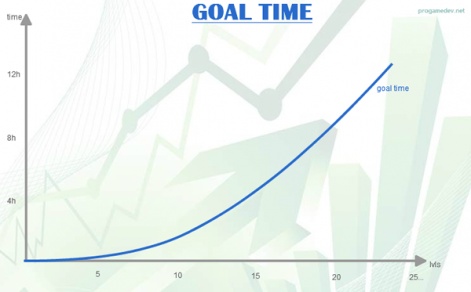
Initially goals should be quick to achieve as this allows players to become familiar with the game mechanics. At this stage, goals should be reached in 5-15 minutes.
As players are drawn into the game then the time to attain goals can be increased but never to less than one goal a day as this seems to be the tipping point into frustration and players quitting games.
We have found that the optimal goal time is 12 hours i.e. two goals per day
- Example: Ferry in Hay Day
The ferry arrives and leaves the farm once a day at a certain time. Each time it features an order the player has to fulfil, but the way it is balanced suggests that the player is unable to fulfil it by himself for the given time.
The farm at the most effective production rate will only be able to provide 70% of the required amount. The other 30% is compensated with real money or utilizing the viral mechanics.
Creative use of deficits
The second parameter of a goal is deficit.
As it can be seen from the chart below, we have defined the production volumes for each level, and now we can form a deficit - the amount of resources the player will lack to achieve the next goal.
In this way, we predetermine the number of actions (and their real money equivalent) and put the deficit into a goal.
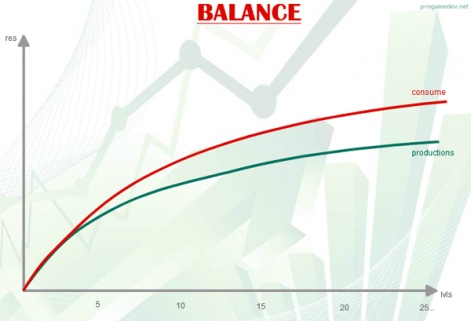
For example: in order to level up we have to complete 3 relatively similar goals. The first goal is to harvest 17 apple crops in the garden. But there is a problem - you only have 5 apple trees in your garden. Thus, during a single session, the player is only able to harvest 5 apple crops.
In the third session, the player completes 2 goals out of 3, and to complete the third goal - the apple one - the player lacks 2 crops (5 x 3 = 15). The next level seems so close but those 2 crops prevent the player from reaching it. At this point many players will opt to buy the outstanding 2 crops rather than complete a fourth havest.
The cost question
The question is how much the 2 apple crops should cost?
Let’s add the goal time under the X axis. Research conducted by Newzoo shows that the players in USA are ready to spend $10-15 in a game on a daily basis.
Therefore, we distribute this amount over the deficit and see how the goal price increases related to the time it takes to achieve that goal.
If it takes 2 hours to grow apples, the goal deficit for 2 apple crops should cost not more than $2.
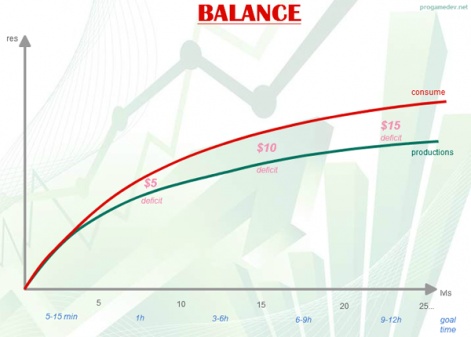
If each new goal requires the player to put much more effort into completing it, eventually they will quit.
In order to keep a game fresh you need to mix things by changing the consumption curve, so at some points it equals zero, while at other ones it goes over the top.
So at times the player will be “beating “ the game and other points will need to purchase additional resources to continue.
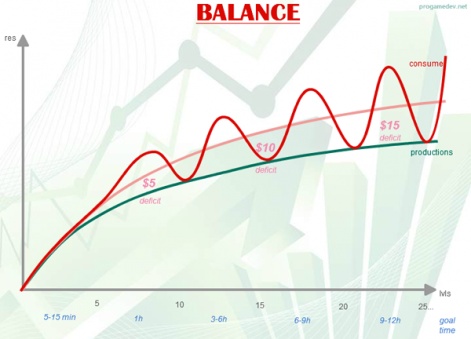
It would be logical to assume that the churn rate will be higher at the points when the deficit goes over the top. By carefully managing the deficit, we will be able to influence the churn avoiding declines in revenues.
You have probably noticed that the deficit of the first 4 levels equals zero. It is not a coincidence!
At times the player will be 'beating' the game and other points will need to purchase additional resources.
Tutorial, acquisitions and engagement should last as long as it takes to lead players to the first difficult point in the game.
If you want to entertain them for a week, and only then ask for payment, the deficit will equal zero up till the 10th level if you use the same time frame.
Breaking it down to sessions
We have already figured out everything regarding goal time and deficit.
The third component of a goal is frequency of actions.
Let us assume that achieving a goal will require 3 game sessions - as in the “apple” example. But this time, to get a new level, I have to complete this goal 3 times.
After each time I complete the goal, I can plant 5 more apple trees, thus, reducing the number of sessions I need to play to complete the next goals. Once I gain the desirable level, the goals change, and get more difficult based on the deficit chart.
Now completing the goal requires harvesting not 15 crops but 45 - and again, 3 sessions…
Another example is a goal that consists of 2 different actions which can't be initially completed during a single session.
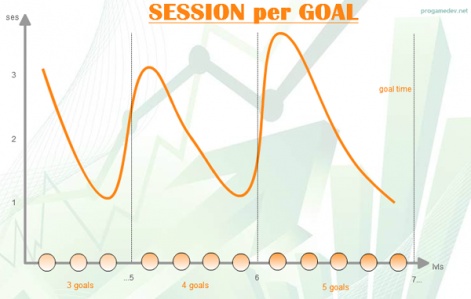
In Hay Day, you have to plant wheat, harvest wheat, use this wheat to produce food for chickens, feed the chickens, the chickens will lay eggs, and the eggs are used to make Bacon and Eggs. The goal is to produce 10 Bacon and Eggs.
By managing the frequency of actions, we predetermine the number of sessions and their length, set timers, sends push-notification, and tune difficulty of the game.
The final goal
The fourth parameter of goal management is the number of goals per level.
As you can see from the chart above, one more session is added with each new level. But you can tweak this parameter as you like in order to generate the highest revenue.
Alternatively a goal can depend on several resources. If you use several types of resources in your game, you can alternate the deficit, and combine it depending on the level.
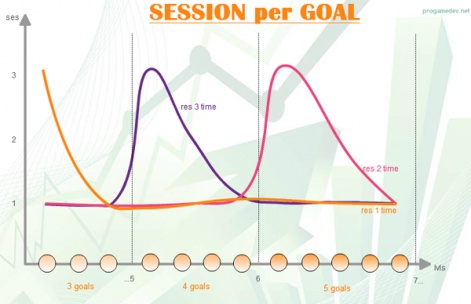
Also you can change the deficit of a certain resources for each goal inside a level, reuse the goals, and conduct wide range of experiments aimed to improve your LTV indicators.
Hopefully this explanation (which has been simplified as much as possible) should help you, as it has helped iLogos, to compose effective asymmetric balance to ensure competitive metrics for your game.
Examples of balance with multiple resources:
- To gain a new level I have to harvest not just 15 crops of apples, but also the same amount of strawberries. It goes pretty well with the apples and I start to invest in strawberries. When I get to the next level with high apple and strawberry production rates, a new deficit is introduced - say potatoes.
- To level up, I have to beat my opponent by upgrading the damage value of my sword. This damage value is enough for the next level, but now I have to upgrade my armour. The level after that, upgrading my sword and armour is not enough - I will have to upgrade magic as well.
- To win the race I have to get more powerful engine, and change the brakes.
In summary what do you have to keep in mind while balancing a game?
- Define how you measure the progress in your game (e.g., level).
- Which goals (actions) the player has to complete to make progress in your game?
- How much time the player has to spend to complete each game goal. What is the frequency?
- What is the deficit for each goal?
- How many goals per level your game has?
- How many sessions the player has to play to achieve a goal?
As mentioned in our introduction, iLogos has used this model to balance and monetise its games. We have found it very effective.
Once the principles are explained it makes sense but of course it still needs fine tuning through trial and error as well as user feedback.






















